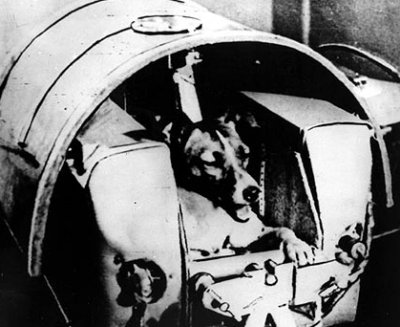The Soviet Union has launched the first ever living creature into the cosmos.
The dog, described as a female Russian breed, was projected into space this morning from Baikonur Cosmodrome aboard the artificial space satellite Sputnik II. Sputnik I, launched on 4 October, is still circling the globe.
The dog has been fitted with monitors to check its heartbeat and other vital signs and was reported to be calm during the first hours of the flight.
Russian scientists are particularly interested in the effects of solar radiation and weightlessness on living organisms.
Fury of animal lovers
Moscow Radio reported the second satellite was launched to commemorate the 40th anniversary of the October Revolution and gave details about the spacecraft’s contents and orbit.
Sputnik II weighs half a ton (508kg) and carries instruments for studying solar and cosmic rays, temperature and pressure, two radio transmitters and a hermetically-sealed container with “an experimental animal” inside, as well as oxygen and food supplies.
It is travelling more than 900 miles, (nearly 1,500 km) above the Earth – higher than Sputnik I – and is orbiting at about five miles (8km) a second.
It will take one hour and 42 minutes to circle the Earth.
The satellite is transmitting telegraphic signals that are being picked up from receiving stations around the globe.
Animal welfare organisations expressed outrage at news that the Russians have sent a dog into outer space.
The National Canine Defence League is calling on all dog lovers to observe a minute’s silence every day the dog is in space.
The RSPCA said it received calls of protest even before the Moscow Radio announcement of the launch had ended.
It has advised those who wish to protest to do so at the Russian Embassy in London.

‘Dog was trained for mission’
It is believed the Russians are planning to catapult the dog back to Earth although there has been no official announcement confirming this.
One British scientist told newspaper reporters the dog had probably been trained for the journey but was unlikely to survive.
“A terrified dog would be useless scientifically,” said Dr William Lane-Petter, Director of the Laboratory Animals Bureau of the Medical Research Council.
“It would not give them the information they want. This dog will have been trained long for the task and subjected to similar simulated conditions, and this flight is just another experience of the same sort.”
In Context
The following day, after several inquiries from Western journalists, Russian officials confirmed the dog’s name as Laika.
The Soviet authorities said Laika died painlessly after a week in orbit but in 2002 new evidence revealed the dog died from over-heating and panic just a few hours after take-off.
Laika’s “coffin” burned up in the Earth’s atmosphere over Barbados on 14 April 1958, five months after launch.
Three years later, the Russians achieved another space first by sending Yuri Gagarin into orbit on 12 April 1961.
The Sputnik II flight made Laika one of the world’s most famous animals and allowed Russian scientists to learn much about the prospects for human space travel.










